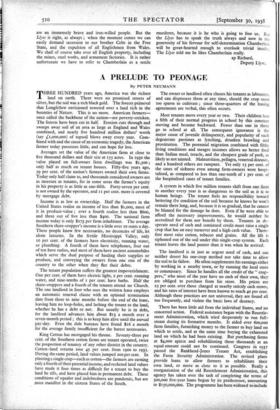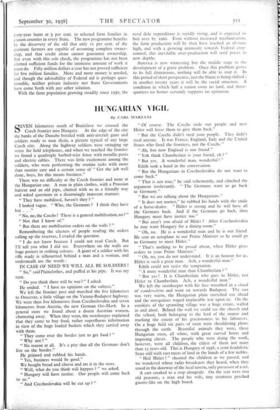A PRELUDE TO PEONAGE
By PETER NEUMANN
Averages set the value of the American farm at close to five thousand dollars and their size at 155 acres. In 193o the value placed on full-owner farm dwellings was $1,5oo ; only half as much on tenant houses. Fifty-five years ago, 59 per cent. of the nation's farmers owned their own farms. Today only half claim to, and thousands considered owners are as insecure as tenants, for in some areas the farmer's equity in his property is as little as one-fifth. Forty-seven per cent. is not owned by the operator, and 11 per cent. more is covered by mortgage debt.
Income is as low as ownership. Half the farmers in the United States realise an income of less than $1,000, most of it in produce-value ; over a fourth realise less than $600, and three out of five less than $400. The national farm income today is only $273 per farm inhabitant. The average Southern share-cropper's income is a little over ro cents a day. These people know few necessaries, no decencies of life, let alone luxuries. In the fertile Mississippi Valley, only to per cent. of the farmers have electricity, running water, or plumbing. A fourth of them have telephones, four out of ten have radios, and most of them have ancient automobiles which serve the dual purpose of hauling their supplies or produce, and conveying the owners from one end of the country to the other when they flee their debts.
The tenant population suffers the greatest impoverishment. One per cent. of them have electric light, 2 per cent. running water, and nine-tenths of r per cent. have baths. Half the share-croppers and a fourth of the tenants attend no Church. The one landlord in four who uses the written lease employs an automatic renewal clause with an optional termination date from three to nine months before the end of the lease, leaving him no loop-holes, and lashing the tenant to the land, whether he has a debt or not. But usually he is in debt, for the landlord advances him about $13 a month over a seven-month period ; this is to keep him alive until the annual pay-day. Even the dole bureaus have found $16 a month for the average family insufficient for the barest necessaries.
King Cotton has mortgaged his throne. Seventy-three per cent. of the Southern cotton farms are tenant operated, twice the proportion of tenancy of any other district in the country. Cotton -land returns rose 45 per cent. from 1900 to 1935. During the same period, land values jumped zoo per cent. In planting a single crop—such as cotton—the farmers are earning only a fourth of their potential income, and rocketed land values have made it four times as difficult for a tenant to buy the land he tills, and have placed him in permanent debt. These conditions of squalor and indebtedness are pandemic, but are most manifest in the sixteen States of the South. The owner or landlord often classes his tenants as labourers, and can dispossess them at any time, should the crop seem too sparse to cultivate ; since three-quarters of the leasing agreements are verbal, this often occurs.
Most tenants move every year or two. Their children lose a fifth of their normal progress in school by this constant moving and become backward. Fewer than one in three go to school at all. The consequent ignorance is the major cause of juvenile delinquency, and popularity of such degenerate pastimes as lynching, drunken brawling and prostitution. The perennial migration combined with filthy living conditions and meagre incomes allows no better food than Indian meal, treacle, and the cheapest grade of pork, as likely as not tainted. Malnutrition, pellagra, venereal diseases, and a hundred others are rampant. Yet only 15 per cent. of the cases of sickness even among farm-owners were hospi- talised, as compared to less than one-tenth of 1 per cent. of the hospitalised cases of tenant families.
A system in which five million tenants shift from one farm to another every year is as dangerous to the soil as it is to human beings. The tenant feels no responsibility toward bettering the condition of the soil because he knows he won't remain there long, and, because it is so gradual, that he cannot be blamed for the damage he does. Even if he were able to afford the necessary improvements, he would neither be accredited for them nor benefit by them. Tenants in de- sperate need of cash and continued credit must raise a single crop that has an easy turnover and a high cash value. There- fore most raise cotton, tobacco and grains. All the life is siphoned out of the soil under this single-crop system. Each tenant leaves the land poorer than it was when he arrived.
The landlord is in just as urgent need of cash, and can neither desert his one-crop method nor take time to allow the soil to lie fallow. He often supplements his earnings either by working in a nearby town, or by running the local store or commissary. Since he handles all the credit of the " crop- pers," who most of the year have no cash of their own, they are obliged to purchase from his store. His prices are 25 per cent. over those charged at nearby strictly cash stores, and his rates of interest have been known to reach 4o per cent. Although these practices are not universal, they are found all too frequently, and violate the basic laws of decency.
There has been little aid from the individual States, and no concerted action. Federal assistance began with the Resettle- ment Administration, which tried desperately to run full- steam during its formative months. It aided over 600,000 farm families, furnishing money to the farmer to buy land on which to settle, and at the same time buying the exhausted land on which he had been existing. But purchasing farms at $4,000 apiece and rehabilitating these. thousands. at an equal amount could not be continued. Congress in 1937 passed the Bankhead-Jones Tenant Act, establishing the Farm Security Administration. The revised plans provide loans to allow farmers to rehabilitate their own land, or move as close to it as possible. Really a reorganisation of the old Resettlement Administration, this agency has taken over the task of completing the terms of 300,000 five-year loans begun by its predecessor, amounting to lit 5o,000,000. The programme has been widened to include forty-year loans at 3 per cent. to selected farm families in chosen counties in every State. The new programme benefits by the discovery of the old that only 11 per cent. of the destitute farmers are capable of assuming complete owner- ship, and that credit alone cannot guarantee ownership. But even with this sole check, the programme has not been allotted sufficient funds for the immense amount of work it must do. Fifty million dollars a year has not proved sufficient for five million families. More and more money is needed, and though the advisability of Federal aid is perhaps ques- tionable, neither private industry nor State Governments have come 'forth with any other solution.
With the farm population growing steadily since 1930, the rural dole expenditure is rapidly rising, and is expected to boil over by 196o. Even without increased mechanisation, the farm production will by then have reached an all-time high, and with a growing animosity towards Federal crop- control, this inevitable over-production will send prices to new depths.
America is now witnessing but the middle stage in the development of a grave problem. Once this problem grows to its full dimensions, nothing will be able to stop it. In this period of short perspective, just the blame is being shifted ; in another twenty years it will be the social structure. A condition in which half a nation owns no land, and three- quarters no homes certainly supports no optimism.















































 Previous page
Previous page